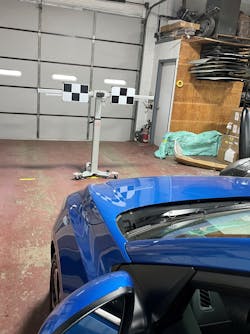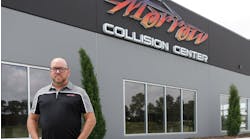It is said that the automotive industry is a never-ending learning curve with many twists in the road ahead. It is the daily challenges that keep me in this business because I can get bored quickly if it becomes too repetitive with the same old daily routine. It is that bump in the road that makes you want to stop and do some research that will only enhance what you know and take you to the next level. It is all about leaving the comfort zone and moving into another dimension that will keep you in the game of automotive technology advancements.
This was the case when I was presented with a 2020 Nissan Sentra (Figure 1) for a routine LKAS windshield camera calibration. The vehicle was involved in roof damage from a fallen tree limb. The roof was beyond repair and had to be replaced along with a new windshield. The LKAS camera that was directly mounted to the upper portion of the windshield had glass particles in the camera lens and the camera looked like it took a direct hit so as a precautionary measure it had to be replaced. When the vehicle was finally finished, there was a warning light on the dash panel alerting the shop to address the LKAS camera system (Figure 2). It was at this point I was called in to perform a full scan of the vehicle and a camera calibration.
When I arrived at the shop, I hooked up my scan tool and scanned the entire vehicle. There was a code C2503:54 stored in the front camera system for “Camera Aiming Incomplete” (Figure 3), so it would only be a matter of setting up my ADAS frame machine to perform the task. I first had to find the centerline of the vehicle by using my plumb bob at the front and rear of the vehicle using the car emblems as a center point and marking the floor below them. Then I used my four-way laser to run a laser line through both my plumb bob marking points on the floor and extending the laser line out in front of the vehicle. My frame had to be at 3000 mm in front of the vehicle as measured from the center of the left front wheel (Figure 4). Once my frame was at the proper distance, I had to make sure both the right and left centers of the targets were 360 mm from the centerline of the frame. Then I had to adjust the frame height so that the center of the horizontal frame arm holding the targets was 1300 mm from the floor.
The one thing to remember is that you must make sure you are on a level floor and your frame stand is properly adjusted so that the bubble gauges on the frame are centered. The ADAS software gives you these set-up procedures so that setting up your frame is a seamless operation. The software will ask you to measure the front wheel housing center heights from the floor and input them. If the readings side to side are not close to one another, you may need to inspect the tires for proper inflation, tire size or even a suspension that has been compromised. The readings on this vehicle were 665 mm for the left front wheel and 670 mm for the right front wheels and everything seemed to be in good order.
The easy part now was to hit the next selection to command the camera calibration, provided that everything was properly set up and the shop lighting and the backdrop behind the frame machine was acceptable. I proceeded with the calibration, but to my surprise the scan tool stopped and gave me an error for “No Communication” (Figure 6). I made sure the ignition key was on because some vehicles with push-button systems can turn themselves off if the ignition is left on too long without starting the vehicle, but it was still on, so I tried this calibration a few more times and kept getting the same screen error on the scan tool.
I did not know whether it was an issue with my scan tool or the vehicle I was working on. The vehicle was a 2020 and my scan tool had the latest updates for a 2021 Nissan vehicle. At this point, that old Kenny Rogers song came to mind: “You’ve got to know when to hold ’em; know when to fold ’em.” So, I decided to lay down my aftermarket scan tool and put my Nissan factory Consult 3+ Scan Tool to work.
I used the Nissan Consult 3+ software and accessed the camera module section of the tool. The software has always used five common menu tabs of Self Diagnostic Codes, Data, Work Support, ECU Info and Configuration. What I noticed was the Work Support tab that held all the bidirectional procedures and commands was missing and a new tab CGW was implemented with a red warning dot next to it.
When I selected the Central Gateway tab, it opened a new menu I have never seen before (Figure 6). This vehicle was in “Restricted Mode” from the manufacturer as part of the 2017 Spy Study Act for Automotive vehicles. This was part of a cybersecurity structure to prevent vehicle hacking by unauthorized equipment hooking into the diagnostic connector, hacking through the onboard telematics system by unwanted internet access or simply by hacking a synced cellphone onboard the vehicle. Some companies have even taken further steps to encrypt messages between controllers onboard the vehicle. Nissan, like many other manufacturers will be doing soon, placed a Security Gateway Module in front of the ALDL connector to block bi-directional commands from entering the onboard computer networks (Figure 7 boxed in red).
The scan tool operator working on a Nissan product will still be allowed to access codes and ata and clear system code,s but the work support functions will not be available because the Central Gateway would have to be switched to the “Open Mode.” I noticed a selection on the lower part of the Consult 3+ screen to place the gateway into an “Open Mode,” so I proceeded with the button and then it took me out to the Nissan Tweddle server where I had to enter my yearly subscription username and password (Figure 8). Once the vehicle was in “Open Mode” there was a green dot on the Central Gateway tab and the Work Support tab was now added to the bar menu (Figure 9). When I selected the Work Support tab, there was a selection to either AUTO AIM the LKAS camera or simply do an AIM CHECK (Figure 10). I hit the AUTO AIM button and was directed through a few screens to enter vehicle measurement specs and the camera was immediately put into alignment.
This simple ADAS job took me through a bunch of loops and turns as if I were doing an automotive shuffle dance because the equipment I purchased to do an ADAS operation could not finish the job on its own. I knew that most of the manufacturers would have to move in this secured gateway direction by 2022 with the introduction of mandated Automatic Emergency Braking for all 2022 model year vehicles. Chrysler/Fiat had already partially started adding secured gateways to selected vehicles in mid-year 2018 and then fully protected their vehicles by 2019. Chrysler/Fiat uses a “Restricted View Only Mode” and they will not allow you to clear any codes or perform bi-directional functions of any kind unless the vehicle is in “Open Mode.” Nissan started in 2020 on some of its models and I was not fully aware of it, so I decided to reach out to a few aftermarket scan tool companies to discuss these issues. It turns out they are in talks with Nissan to hammer out the details of how they will be moving forward to allow techs access to Nissan vehicle systems with aftermarket tools.
My concern is that there will be many more manufacturers starting to lock down their vehicles with a secured gateway and there is no one portal mandated for these manufacturers to use. They could each run their own subscription-based portals with a two-tier security token access to unlock their vehicles. This would be hard on aftermarket scan tool companies because they would have to structure each manufacturer to access different portals with different usernames and passwords. The independent subscriptions alone could be costly for an aftermarket scan tool user who would have to register with many different manufactures. I am just hoping that they all decide to use AutoAuth.com like Chrysler/Fiat is now doing as a common portal, but at this point it is a wait and see situation. I hope this story has hit home with the technicians and industry leaders out there who have already experienced the issues of security gateway lockout. It is an ongoing challenge and one that shows no signs of slowing down.



